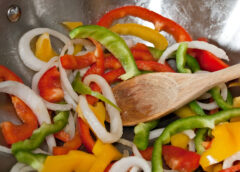
Chinese Food, American Style
By Dale Phillip
It is often a standing joke that what Americans consider to be Chinese food is totally of our own making, and cooks and diners in China would find them completely foreign (like chop suey–what on earth is that?). But somewhere along the line, Chinese food was adapted from our Asian immigrants, Americanized and became wildly popular, not only as a take-out but served buffet-style and sit-down as well. Many dishes are accompanied by plain white, brown or fried rice. Let’s review our most popular:
Dim Sum: bite-sized dumplings stuffed with veggies or meat,essentially a Cantonese preparation not always offered at many restaurants; can be also presented as small sampling dishes, depending on the menu and the cook’s whim;
Hot and Sour Soup: a delightfully “sour” soup with a spicy broth, it contains red peppers or white pepper and vinegar; another favorite soup is a light broth with won ton (meat-filled dumplings);
Quick Noodles: a staple in every Chinese home and found on most Chinese restaurant menus, it comes in several versions, often called lo mein and may be plain or have veggies;
Szechwan Chilli Chicken: a fiery Sichuan delight loaded with pungent spices like ginger, green and red chillies and brown pepper; be careful if you are not a fan of hot chilli peppers;
Spring Rolls: frequently a lighter version of traditional egg rolls, which are shredded meat and veggies encased in a papery thin dough, rolled and deep fried; a favorite to be sure;
Egg Foo Young: an egg pancake with veggies, often too bland for Chinese foodies, served with a brown sauce;
Shitake Fried Rice with water Chestnuts: mushrooms and water chestnuts are used frequently in Chinese cooking, and this is just another version of traditional fried rice; some things never go out of style;
Moo Shu: stir-fried veggies and meat, chicken, shrimp or tofu, rolled up in thin pancakes spread with plum sauce (this author’s favorite dish);
Kung Pao Chicken: savory pieces of chicken cooked in a wok with veggies and flavored with peanuts and spices; from the time of the Qing Dynasty (circa 1876);
General Tso Chicken: deep-fried chicken dish in a tangy sauce, an all-time favorite; it may have been named in honor of a Qing dynasty military leader, but it’s really anyone’s guess;
Orange Chicken: another popular deep-fried chicken dish, coated with an orange sauce after cooking (not for a low-fat diet, to be sure);
Peking Duck: don’t expect this specialty to be readily available at many Chinese restaurants, Peking duck harkens back to the Imperial Era (221 B.C.) and characterized by its thin, crisp skin; often must be ordered ahead of time but fit for an emperor;
Like many other cuisines, Chinese cooking uses sauces and seasonings native to their regions, which might include:
soy sauce
oyster sauce
sesame oil
rice vinegar
rice wine
soybean paste
star anise
five spice powder
chili sauce (or paste)
chili powder
sichuan peppercorns
black bean sauce
Many of these are available in the Asian aisle of your local grocery store or a multitude of Asian grocers in larger cities and can be great fun to try in your own kitchen. So look up the closest Chinese buffet or restaurant, bring your appetite and get ready to sample some of American’s favorite foods. As the old saying goes, you may be hungry an hour later, but it’s well worth it.
Author Dale Phillip admits that Chinese food is one of her favorites, and going overboard at a good Chinese buffet is one of life’s great pleasures. Her favorite dish is Moo Shu with tofu (extra plum sauce, please), and Hot and Sour soup. She often makes a meal on fried rice with lots of soy sauce (low-sodium). Please view her many articles in the Food and Drink category, and her blog: http://myfriendlyu.blogspot.com/
Article Source: https://EzineArticles.com/expert/Dale_Phillip/1169732
http://EzineArticles.com/?Chinese-Food,-American-Style&id=9943171


